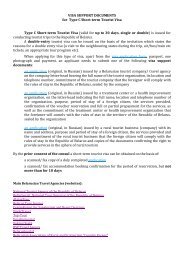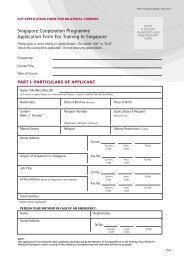Human Development Report 2013 - UNDP
Human Development Report 2013 - UNDP
Human Development Report 2013 - UNDP
You also want an ePaper? Increase the reach of your titles
YUMPU automatically turns print PDFs into web optimized ePapers that Google loves.
<strong>Human</strong> <strong>Development</strong> <strong>Report</strong> <strong>2013</strong>The Rise of the South <strong>Human</strong> Progress in a Diverse WorldEDUCATIONALATTAINMENT GROSS ENROLMENT RATIO EDUCATION QUALITYAdultliteracyratePopulationwith atleastsecondaryeducation Primary Secondary TertiaryPrimaryschoolteacherstrainedto teachPerformance of 15-year-old studentsMean scoreDeviation from meanSatisfactionwitheducationqualityPrimaryschooldropoutrate(% ages15 andolder)(% ages 25and older) (%) (%) Reading a Mathematics b Science c Reading Mathematics Science (% satisfied)(% ofprimaryschoolcohort)HDI rank 2005–2010 d 2010 2002–2011 d 2002–2011 d 2002–2011 d 2005–2011 d 2009 2009 2009 2009 2009 2009 2011 2002–2011 d171 Sudan 71.1 h 15.5 f 73.0 39.0 6.1 59.7 .. .. .. .. .. .. 43.0 9.1172 Zimbabwe 92.2 h 55.4 f .. .. 6.2 .. .. .. .. .. .. .. 66.4 ..173 Ethiopia 39.0 .. 102.0 36.0 5.5 39.4 .. .. .. .. .. .. .. 52.5174 Liberia 60.8 i 27.3 f 96.0 .. 19.1 40.2 .. .. .. .. .. .. 49.6 54.4175 Afghanistan .. 20.3 f 97.0 46.0 3.3 .. .. .. .. .. .. .. 58.5 ..176 Guinea-Bissau 54.2 h .. 123.0 36.0 2.7 38.9 .. .. .. .. .. .. .. ..177 Sierra Leone 42.1 14.8 125.0 .. 2.1 48.0 .. .. .. .. .. .. 35.3 ..178 Burundi 67.2 h 7.1 f 156.0 25.0 3.2 91.2 .. .. .. .. .. .. 70.9 43.8178 Guinea 41.0 h .. 94.0 38.0 9.5 65.2 .. .. .. .. .. .. 39.0 34.3180 Central African Republic 56.0 h 17.9 f 93.0 13.0 2.6 .. .. .. .. .. .. .. 40.7 53.1181 Eritrea 67.8 h .. 45.0 32.0 2.0 93.8 .. .. .. .. .. .. .. 31.0182 Mali 31.1 10.3 82.0 39.0 5.8 50.0 .. .. .. .. .. .. 34.6 24.5183 Burkina Faso 28.7 2.0 79.0 23.0 3.3 85.7 .. .. .. .. .. .. 53.0 36.4184 Chad 34.5 h .. 90.0 26.0 2.2 45.3 .. .. .. .. .. .. 60.1 76.7185 Mozambique 56.1 h 3.6 f 115.0 25.0 1.5 75.9 .. .. .. .. .. .. 63.2 64.6186 Congo, Democratic Republic of the 66.8 h 23.2 f 94.0 38.0 6.2 91.7 .. .. .. .. .. .. 39.3 45.2186 Niger 28.7 5.1 f 71.0 13.0 1.5 96.4 .. .. .. .. .. .. 55.3 30.7Other countries or territoriesKorea, Democratic People’s Rep. of 100.0 .. .. .. .. .. 539 .. .. .. .. .. .. ..Marshall Islands .. .. 102.0 99.0 16.2 .. .. .. .. .. .. .. .. 16.5Monaco .. .. .. .. .. .. .. .. .. .. .. .. .. ..Nauru .. .. 93.0 63.0 .. 74.2 .. .. .. .. .. .. .. ..San Marino .. .. 94.0 97.0 .. .. .. .. .. .. .. .. .. ..Somalia .. .. 32.0 8.0 .. .. .. .. .. .. .. .. .. ..South Sudan .. .. .. .. .. .. .. .. .. .. .. .. .. ..Tuvalu .. .. 100.0 .. .. .. .. .. .. .. .. .. .. ..<strong>Human</strong> <strong>Development</strong> Index groupsVery high human development .. 85.9 104.2 100.4 75.8 .. — — — — — — 61.3 3.8High human development 92.7 64.2 110.5 91.0 48.7 .. — — — — — — 58.0 7.3Medium human development 82.3 50.5 113.4 70.7 22.1 .. — — — — — — 69.2 18.8Low human development 60.8 25.2 98.2 37.4 6.8 73.8 — — — — — — 56.5 41.7RegionsArab States 74.5 38.4 97.7 71.1 24.1 .. — — — — — — 50.0 9.9East Asia and the Pacific 93.8 .. 111.0 78.8 26.1 .. — — — — — — .. ..Europe and Central Asia 98.1 83.5 99.9 91.2 57.5 .. — — — — — — 51.8 4.2Latin America and the Caribbean 91.3 50.4 115.9 90.9 42.5 92.3 — — — — — — .. 14.3South Asia 62.8 39.2 113.6 57.6 15.7 77.2 — — — — — — 73.3 21.4Sub-Saharan Africa 63.0 29.7 100.3 40.3 6.2 73.9 — — — — — — 52.0 37.8Least developed countries 60.7 .. 101.8 36.0 6.6 71.9 — — — — — — 58.2 40.9Small island developing states .. .. 97.0 77.0 45.2 89.4 — — — — — — .. ..World 81.3 57.7 107.9 71.2 28.7 .. — — — — — — 64.2 18.0NOTESa Average score in reading for Organisation forEconomic Co-operation and <strong>Development</strong> (OECD)countries is 493.b Average score in mathematics for OECD countriesis 495.c Average score in science for OECD countries is 501.d Data refer to the most recent year availableduring the period specified.e Average of two or more surveys during the period.f Barro and Lee (2011) estimates for 2010.g Refers to 2011.h United Nations Educational, Scientific andCultural Organization Institute for Statistics (UIS)estimate derived from its Global Age-specificLiteracy Projections Model, which is based onnational data since 2000.i UIS estimate derived from its Global Age-specificLiteracy Projections Model, which is based onnational data from before 2000.j Refers to Dubai only.k Refers to Shanghai only.DEFINITIONSAdult literacy rate: Percentage of the populationages 15 and older who can, with understanding, bothread and write a short simple statement on theireveryday life.Population with at least secondary education:Percentage of the population ages 25 and older thatreached at least secondary education.Gross enrolment ratio: Total enrolment in a givenlevel of education (primary, secondary or tertiary),regardless of age, expressed as a percentage of theofficial school-age population for the same level ofeducation.School teachers trained to teach: Percentageof primary school teachers that have received theminimum organized teacher training (pre-service orin-service) required for teaching at the primary level.Performance in reading, mathematics andscience: Score obtained in testing of skills andknowledge of 15-year-old students in these subjectsessential for participation in society.Deviation from mean: Spread of scores in reading,mathematics and science relative to the averagescores.Satisfaction with education quality: Percentageof respondents who answered “satisfied” to theGallup World Poll question, “Are you satisfied ordissatisfied with the education system?”Primary school dropout rate: Percentage ofstudents from a given cohort that have enrolled inprimary school but that drop out before reachingthe last grade of primary education. It is calculatedas 100 minus the survival rate to the last grade ofprimary education and assumes that observed flowrates remain unchanged throughout the cohort lifeand that dropouts do not re-enter school.MAIN DATA SOURCESColumns 1, 2–6 and 14: UNESCO Institute forStatistics (2012).Columns 7–12: OECD (2010).Column 13: Gallup (2012).Table 8 Education | 173
















